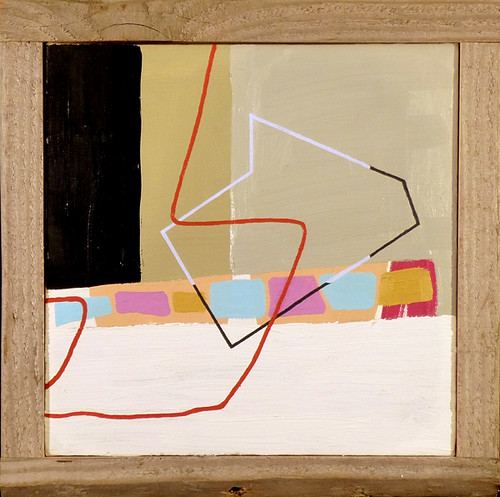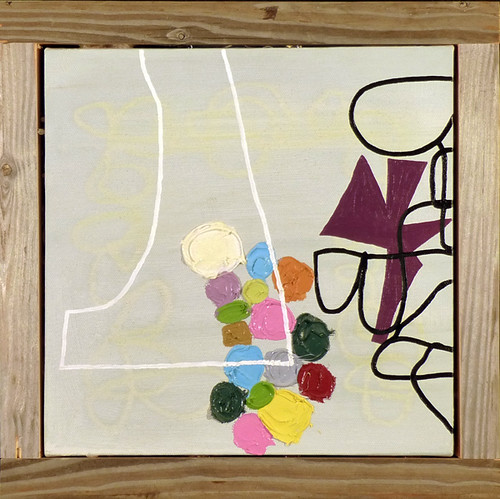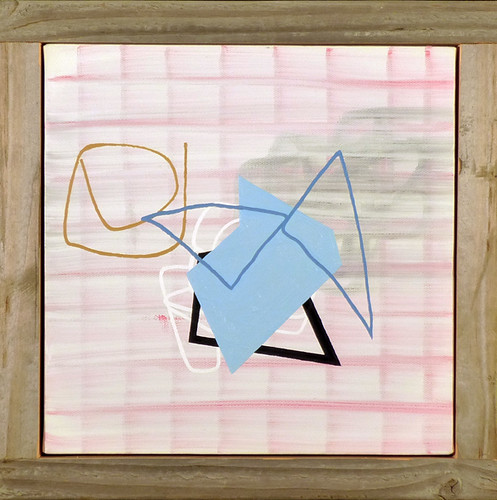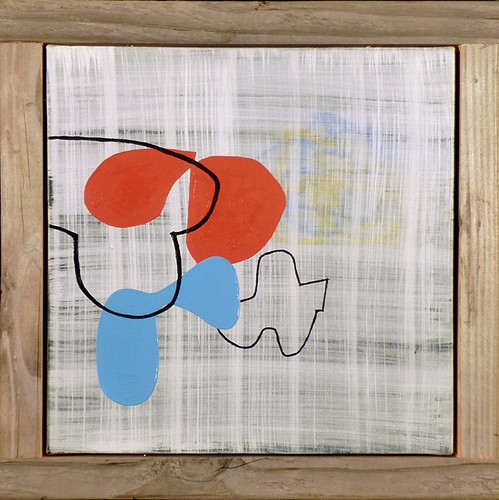Michael Randall at 490 Atlantic
Michael Randall at 490 Atlantic "Twenty (odd) small paintings"
“I believe that both painting and abstraction -- far from being exhausted, irrelevant or dead -- still contain limitless fresh possibilities.” -Michael Randall
I first became acquainted with the paintings of Michael Randall when I found a batch of cast-off watercolors in the garbage outside his building. I liked the energy of the abstract forms, the vitalism they seemed to exude, encompassing both a joyous buoyancy and an undefined anxiety. I scooped them up and took them home. (My entire art collection is composed of works the artists themselves have rejected. Many of these end up in storage.) Some of the Randalls still hang on my walls.
That was many years ago and Randall’s work has evolved since then while maintaining its devotion to the “continuum of abstraction.” If anything the work has grown more intimate, more inviting and friendly. Randall is a regular at such galleries as Sideshow in Brooklyn, and he was part of a recent two-man show (with Victor Kord) at The Lobby Gallery of The Durst Organization in midtown. This latter show presented larger pieces, but Randall works equally well in small scale. His current show at 490 Atlantic gallery in Brooklyn presents twenty-three uniformly-sized small paintings. The way the paintings are displayed, the size and framing tends to link the images, suggesting a series or progression. However, the many obvious differences between the images belie that idea. The musical quality of the work does at least point to the possibility.
As with much abstract painting one does tend to make the immediate analogy to music: i.e. the painting as a frozen Planck-frame portrait of a universe whose structure is primarily musical. These paintings definitely live up to that expectation, and the artist does not deny this, in fact he aspires to it: “the elements fall imperfectly into a satisfying and/or dissonant relationship, and a sort of music begins to take shape.” Synesthesia too comes into play as we almost hear the relationships, the tensions, positive or otherwise in these works. Within the tangled knots of musicality we see the shapes of echoes or broadcast circles. Globular forms and outlines argue on the canvas. Or is it a party? We don’t know where the discussion is going, whether it is collapsing or expanding. We may well read it as a contest between void and suggestion. But suggestion of what? Is there a primal ground intended, or a Platonic master in the wings with a whip?
Despite the focus on form, we are not dealing with Platonism here. There is no ideal that these forms reflect or suggest; they merely arise—random images generated by random dynamics. Or rather not so random. The artist claims they are the product of both improvisation and planning, of system and idea. However, for this viewer, looking at Randall’s paintings is like peering into a very intimate, obscure corner of the physical universe, the back of a closet or the inside of a wallpapered cabinet, some recess far beyond and far hidden from the prying eyes of the meaning-seeking machinery of the human mind. For this reason I have come up with the term “household intimacy” to describe this particular quality of the Randall gestalt.
And while motion and dynamism seem to be an integral aspect to the work, I want to stress that there is strong sense of stasis as well, a moment of frozen tension before the discussion begins. And discussions, as we all know, tend to grow confused, to knot themselves up and often go nowhere. Many of the paintings do seem to struggle internally, even tie themselves into stillness. And therein lies the paradox—dynamism in stasis? What exactly are we perceiving? Perhaps it is merely the thinnest possible slice of time and space that precedes an act or event.
Neuroscientists have found that the actual physical decision to commit to an act is registered in the brain and body chemistry sometime before the brain understands itself to be making a decision. This obviously plays hell with our ideas of free will, but it provides a new territory for the artist—to map that ambiguous and fragile background. In Randall’s work, (if we choose to look at it musically), it is as if we were peering into the nano-moment precedent to a musical exchange, the chemical reaction (rendered graphically) before the note is actually played. One could not, and need not, say, however, that this is a Bach moment or a Coltrane moment or even a George Jones moment. One need not even claim music as a necessary framework. We are, in fact, somewhere before such designations even matter—the primal soup out of which a bent third or an overzealous brush stroke or even a rhyming word arises.
What is fascinating about Randall’s work is the way he grounds his explorations in the aura of our everyday existence. I have already mentioned a certain “household intimacy” that informs the work. This intimacy has several dimensions: the first being humor, something not often found in abstraction. There is a kind of Sunday morning comic-strip quality from which all character and narrative has drained away, or never was. What is left is the trace, or, more accurately, the argument that preceded the image. I think it comes from a projected ease and (perhaps illusory) lack of decorum. There is something friendly about the images; you don’t feel you’re being lectured at by an MFA candidate, and that makes looking at these works a pleasure. Another aspect of the intimacy are the backgrounds on which Randall’s dynamics takes place, which are, often as not, seemingly textured with a muted wallpaper/canvas tablecloth grid of familiarity. The intimacy is again increased by the artist’s decision to frame each painting in a simple square of grayed old wood such as you would find piled next to a barn out in the country.
Randall makes abstract art, and would likely disapprove of my attempts to find any meaning in it. As he states, “The point of these paintings is what they look like – a communication at once direct and mysterious. In the purest sense, these paintings are ‘about’ the abstract emotional effects of line, color and form.” The painting must “live or die according to its own rules,” in other words, as pure experience, not as reflection or afterthought or thesis. As such Randall’s work forms a bridge between esoteric speculation and raw perception. It is both idea and thing and neither. The intimacy I mentioned earlier is not only sensual but temporal. These paintings are happening now, in the recesses of quotidian existence: behind the bed, behind that cabinet that hasn’t moved in years, buried in a taped-up box of clothes ready to go to the Salvation Army. Open that old trunk and before you categorize what you see, a dance is happening: the jagged boundary waltzes with the gaseous expanse, the geometric edge two-steps with the formless fluid, the void jitterbugs with gestures of containment and, as we all know, where void is contained creation begins—and from thence, possibility.
There is a constant sense in these paintings of something that both has already been and is about to take place. They exude the vagueness of memory and amorphous hope of anticipation. What more could you ask for in our over-defined world?
"Michael Randall: Twenty (odd) small paintings" is shown at the 490 Atlantic Gallery. The show runs until April 13th. Make the trip.
Reviewed by Carl Watson





